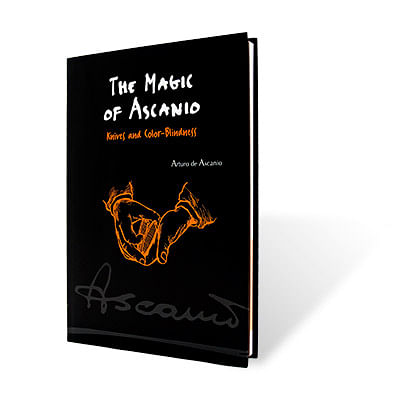The Magic of Ascanio: Ascanio's Knives and Color Blindness by Arturo de Ascanio
Reviewed by Jamy Ian Swiss (originally published in Genii January, 2009)

Arturo de Ascamop is known to us as a master of magic with playing cards, and thanks in no small measure to the trilogy of his works assembled by Jesus Etcheverry, Ascanio's contributions will be studied and celebrated by generations of cardicians to come. But Ascanio also had an early passion for the Color-Changing Knives, and if you wonder what the brilliance of an Ascanio might bring to such a commonplace and oft-abused magic prop, then you need wonder no longer.
In 1958, with the help of the Spanish Society of magicians, Ascanio first released Knives and Color-Blindness, when he was 29, first establishing his name in magic as a creative force with which to be reckoned; a dozen years later he would take the prize in close-up cards at FISM. I first became aware of some of Ascanio's work in this arena in 1975, when Jose de la Torre translated a version of the book into English as Ascanio's World of Knives. Although that edition failed to do complete justice to the Spanish original, nevertheless it taught me Ascanio's subtle ideas about display moves, and clever alternatives to the standard Paddle Move, that I have retained ever since. When I first encountered Juan Tamariz, in the very early 1980s at the 4F convention, I saw him repeatedly demolish well-posted magicians with his clever approaches to the knives, undoubtedly influenced by his mentor, Ascanio.
The first section of the book concerns technique, and here are various approaches to displaying the knives, creating magical color changes, and secretly switching knives, including some clever yet practical ideas for the latter. Exploring the notion that it is more convincing to allow the audience to recognize the condition of the knives on their own, rather than to deliberately try to call attention to the color on both sides of the knife (a truly silly practice), Ascanio offers a number of subtle and sometimes skillful solutions, in which the sides of the knives are apparently displayed in the course of other natural actions, such as opening, testing, and closing the blade, blowing on the knife, polishing it on the sleeve, or casually (!) tossing it from hand to hand. Even if you already have a routine set in stone, these subtleties and improvements will be worth the price of the book to you in their ability to enhance the magical nature of the effect. Although the pocket knife as a daily accoutrement has suffered greatly since the advent of post-9/11 security theater, nevertheless the charm and utilitarian ordinariness of the object continues to render its magical usage vastly preferable to "paddles," items that only exist in the magic shop dimension of the universe.
The second section provides routines and ideas from a variety of contributors, including excellent versions from Fred Kaps and Lewis Ganson, and Ascanio's own surprise-filled title routine, "Knives and Color Blindness." Several more techniques and routines are provided courtesy of Ascanio's Spanish friends and colleagues, including Arnaldo Curia, Jose Paytubf, and Martinez Muro. Ascanio's pet routine is as magical today as it was 40 years ago, filled with multiple color changes, transpositions, and surprises. There is still good work to be found on the Color Changing Knives elsewhere in the literature from Matt Schulien's distinctive routine to Joe Mogar's thorough book on the subject and now, no study of this venerable trick will be complete with Ascanio's artistic and innovative contributions.

